April 2014 lunar eclipse
| Total lunar eclipse April 15, 2014 | |
|---|---|
 Lomita, California, 7:44 UTC near greatest eclipse | |
 The Moon passes right to left through the Earth's shadow. | |
| Gamma | -0.3017 |
| Saros (and member) | 122 (56 of 75) |
| Duration (hr:mn:sc) | |
| Totality | 1:18:38 |
| Partial | 3:35:24 |
| Penumbral | 5:47:12 |
| Contacts (UTC) | |
| P1 | 4:52:00 |
| U1 | 5:57:58 |
| U2 | 7:06:21 |
| Greatest | 7:45:39 |
| U3 | 8:24:59 |
| U4 | 9:33:22 |
| P4 | 10:39:12 |
 The lunar eclipse occurred in the constellation Virgo, near the star Spica with the planet Mars near, slightly west on the ecliptic. | |
A total lunar eclipse took place on April 15, 2014. It was the first of two total lunar eclipses in 2014, and the first in a tetrad (four total lunar eclipses in a series). Subsequent eclipses in the tetrad are those of October 8, 2014, April 4, 2015, and September 28, 2015.
The eclipse was visible in the Americas and the Pacific Ocean region, including Australia and New Zealand. During the 5 hour, 44 minute-long eclipse, the Moon passed south of the center of the Earth's shadow. As a result, the northern part of the Moon was noticeably darker than the southern part. Totality lasted for 1 hour 18 minutes. The eclipse occurred during the ascending phase of the Moon's orbit, part of lunar saros 122. Mars was near opposition.
This is the 56th member of Lunar Saros 122. The previous event was the April 1996 lunar eclipse. The next event will be April 2032 lunar eclipse.
Background
A lunar eclipse occurs when the Moon passes within Earth's umbra (shadow). As the eclipse begins, the Earth's shadow first darkens the Moon slightly. Then, the shadow begins to "cover" part of the Moon, turning it a dark red-brown color (typically - the color can vary based on atmospheric conditions). The Moon appears to be reddish because of Rayleigh scattering (the same effect that causes sunsets to appear reddish) and the refraction of that light by the Earth's atmosphere into its umbra.[1]
The following simulation shows the approximate appearance of the Moon passing through the Earth's shadow. The Moon's brightness is exaggerated within the umbral shadow. The northern portion of the Moon was closest to the center of the shadow, making it darkest, and most red in appearance.

Description

On April 15, 2014, the Moon passed through the southern part of the Earth's umbral shadow.[2] It was visible over most of the Western Hemisphere, including east Australia, New Zealand, the Pacific ocean, and the Americas.[3] In the western Pacific, the first half of the eclipse occurred before moonrise. In Europe and Africa, the eclipse began just before moonset.[2] Mars, which had just passed its opposition, appeared at magnitude -1.5 about 9.5° northwest of the Moon.[3][2][4][5] Spica was 2° to the west, while Arcturus was 32° north. Saturn was 26° east and Antares 44° southeast.[2]
The Moon entered Earth's penumbral shadow at 4:54 UTC and the umbral shadow at 5:58. Totality lasted for 1 hour 18 minutes, from 7:07 to 8:25. The moment of greatest eclipse occurred at 7:47. At that point, the Moon's zenith was approximately 3,000 kilometres (1,900 mi) southwest of the Galápagos Islands. The Moon left the umbra shadow at 9:33 and the penumbra shadow at 10:38.[2]
The peak umbral magnitude was 1.2907, at which moment the northern part of the moon was 1.7 arc-minutes south of the center of Earth's shadow, while the southern part was 40.0 arc-minutes from center. The gamma of the eclipse was -0.3017.[2]
The eclipse was a member of Lunar Saros 122. It was the 56th such eclipse.[2]
| Geographic visibility |
|---|
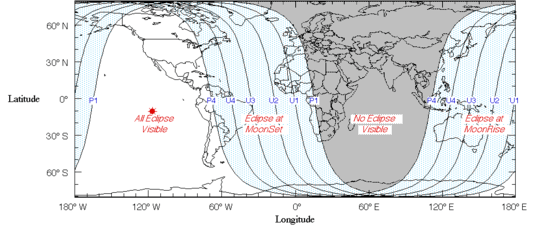 |
Timing
| Timezone adjustments from UTC |
+12h | -9h | -8h | -7h | -6h | -5h | -4h | -3h | ||
|---|---|---|---|---|---|---|---|---|---|---|
| NZST | HADT | AKDT | PDT | MDT | CDT PET |
EDT BOT |
ADT AMST ART | |||
| Event | Evening April 15 | Evening April 14 | Morning April 15 | |||||||
| P1 | Penumbral begins* | N/A† | 7:54 pm | 8:54 pm | 9:54 pm | 10:54 pm | 11:54 pm | 12:54 am | 1:54 am | |
| U1 | Partial begins | 5:58 pm | 8:58 pm | 9:58 pm | 10:58 pm | 11:58 pm | 12:58 am | 1:58 am | 2:58 am | |
| U2 | Total begins | 7:07 pm | 10:07 pm | 11:07 pm | 12:07 am | 1:07 am | 2:07 am | 3:07 am | 4:07 am | |
| Mid-eclipse | 7:47 pm | 10:47 pm | 11:47 pm | 12:47 am | 1:47 am | 2:47 am | 3:47 am | 4:47 am | ||
| U3 | Total ends | 8:25 pm | 11:25 pm | 12:25 am | 1:25 am | 2:25 am | 3:25 am | 4:25 am | 5:25 am | |
| U4 | Partial ends | 9:33 pm | 12:33 am | 1:33 am | 2:33 am | 3:33 am | 4:33 am | 5:33 am | 6:33 am | |
| P4 | Penumbral ends | 10:38 pm | 1:38 am | 2:38 am | 3:38 am | 4:38 am | 5:38 am | 6:38 am | 7:38 am | |
* The penumbral phase of the eclipse changes the appearance of the Moon only slightly and is generally not noticeable.[6]
† The Moon was not visible during this part of the eclipse in this time zone.
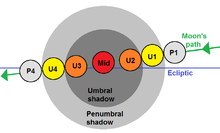
The timing of total lunar eclipses are determined by its contacts:[7]
- P1 (First contact): Beginning of the penumbral eclipse. Earth's penumbra touches the Moon's outer limb.
- U1 (Second contact): Beginning of the partial eclipse. Earth's umbra touches the Moon's outer limb.
- U2 (Third contact): Beginning of the total eclipse. The Moon's surface is entirely within Earth's umbra.
- Greatest eclipse: The peak stage of the total eclipse. The Moon is at its closest to the center of Earth's umbra.
- U3 (Fourth contact): End of the total eclipse. The Moon's outer limb exits Earth's umbra.
- U4 (Fifth contact): End of the partial eclipse. Earth's umbra leaves the Moon's surface.
- P4 (Sixth contact): End of the penumbral eclipse. Earth's penumbra no longer makes contact with the Moon.
Viewing events
Many museums and observatories planned special events for the eclipse. The United States National Park Service sponsored events at Great Basin National Park and Sleeping Bear Dunes National Lakeshore.[8] The University of Hawaii's Institute for Astronomy held events at two locations on the islands.[9] The Griffith Observatory in Los Angeles, California streamed the eclipse live on the Internet.[3]
NASA hosted two live question-and-answer sessions online. The first happened roughly 12 hours before the eclipse via Reddit's Ask Me Anything. The second was a web chat hosted on NASA's site just before the eclipse began. NASA also streamed the eclipse live on their website.[10] NASA TV provided 3 hours of live coverage beginning at 2 a.m. EDT.[11]
Gallery
| Wikimedia Commons has media related to Lunar eclipse of 2014 April 15. |
-

Simulation of Earth from the Moon, 7:47 UTC
-
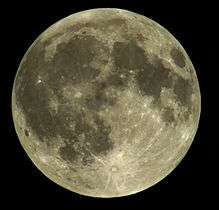
Pre-eclipse in Minneapolis, 3:50 UTC
-

Albuquerque, New Mexico, 6:02 UTC
-

Rosemead, California, 6:30 UTC
-
%2C_Albuquerque%2C_NM.jpg)
Albuquerque, New Mexico, 6:45 UTC
-
.jpg)
New Braunfels, Texas, 7:02 UTC
-
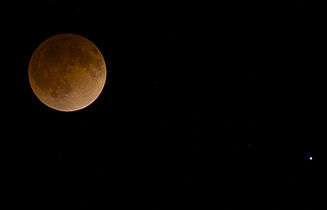
West Valley City, Utah, 7:29 UTC
Moon with Spica -
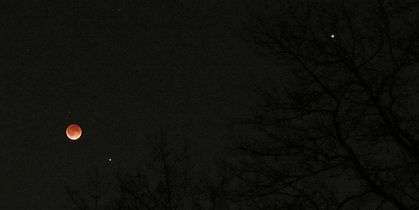
Minneapolis, 7:40 UTC
wide angle with Mars -
Tustin, California, 7:40 UTC
-
Tustin, California, 7:40 UTC
-
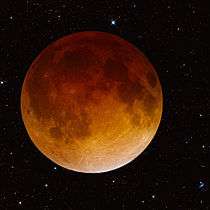
Charleston, West Virginia, 7:44 UTC
The full eclipse by R. Jay GaBany -

Minneapolis, Minnesota, 7:46 UTC
-

San Jose, California, 7:46 UTC
-
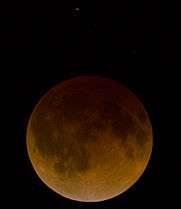
Albuquerque, New Mexico, 7:49 UTC
-

Dolores, Uruguay
between the church´s tower. -

San Jose, California, 8:23 UTC
End of totality -
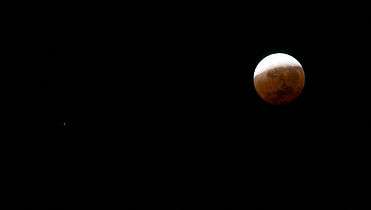
Montevideo, Uruguay, 8:43 UTC
-

Queenscliff, Victoria, 9:14 UTC
Relation to prophecy
Starting in 2008, Christian pastors John Hagee and Mark Biltz began teaching "blood moon prophecies": Biltz said the Second Coming of Jesus would occur at the end of the tetrad that began with the April 2014 eclipse, while Hagee said only that the tetrad is a sign of something significant.[12] The idea gained popular media attention in the United States, and prompted a response from the scientific radio show Earth & Sky.[3][13] According to Christian Today, only a "small group of Christians" saw the eclipse as having religious significance, despite the attention.[14]
Related eclipses
The April 15 eclipse was the first eclipse in a tetrad; that is, four consecutive total eclipses with no partial eclipses in between. There will be another eclipse every six lunar cycles during the tetrad – on October 8, 2014, April 4, 2015, and September 28, 2015.[3] The lunar year series repeats after 12 cycles, or 354 days, causing a date shift when compared to the solar calendar. This shift means the Earth's shadow will move about 11 degrees west in each subsequent eclipse.
This tetrad started during the ascending node of the Moon's orbit. It is the first tetrad since the 2003–04 series, which started in May. The next series will be from 2032 to 2033, starting in April.
| Lunar eclipse series sets from 2013–2016 | ||||||
|---|---|---|---|---|---|---|
| Ascending node | Descending node | |||||
| Saros | Viewing date |
Type | Saros | Viewing date |
Type | |
112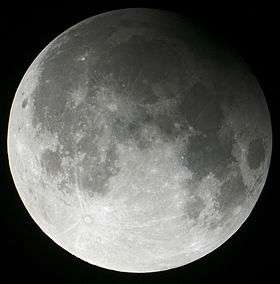 |
2013 Apr 25 |
Partial |
117 | 2013 Oct 18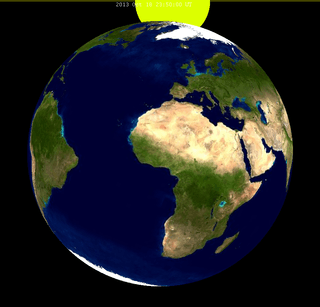 |
Penumbral | |
122 |
2014 Apr 15 |
Total |
127 |
2014 Oct 08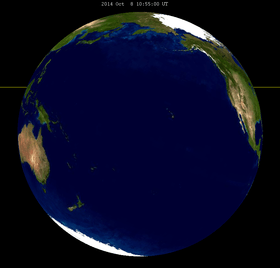 |
Total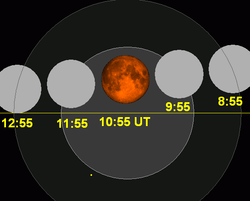 | |
132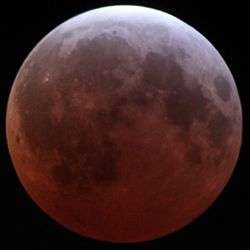 |
2015 Apr 04 |
Total |
137 |
2015 Sep 28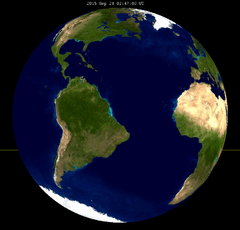 |
Total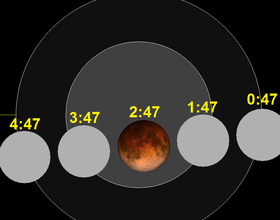 | |
| 142 | 2016 Mar 23 |
Penumbral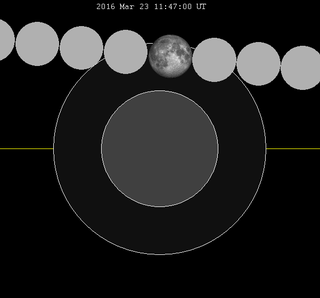 |
147 | 2016 Sep 16 |
Penumbral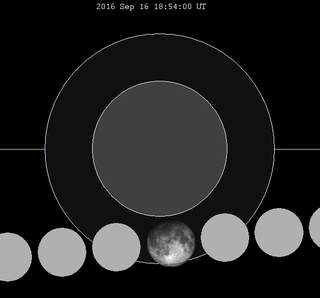 | |
| Last set | 2013 May 25 | Last set | 2012 Nov 28 | |||
| Next set | 2017 Feb 11 | Next set | 2016 Aug 18 | |||
Half-Saros cycle
A lunar eclipse will be preceded and followed by solar eclipses by 9 years and 5.5 days (a half saros).[15] This lunar eclipse is related to two hybrid total/annualar solar eclipses of solar saros 129.
| April 8, 2005 | April 20, 2023 |
|---|---|
 |
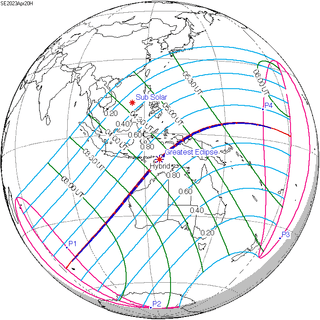 |
See also
References
- ↑ Fred Espenak and Jean Meeus. "Visual Appearance of Lunar Eclipses". NASA. Retrieved April 13, 2014.
- 1 2 3 4 5 6 7 Espenek, Fred. "Eclipses During 2014". NASA. Retrieved April 3, 2014.
- 1 2 3 4 5 Elizabeth Weise (April 3, 2014). "Blood moon eclipse on April 15 is a special event". USA Today. Retrieved April 3, 2014.
- ↑ "Sneak peek and quick observing guide to April's opposition of Mars". Astro Bob. February 3, 2014.
- ↑ Beish, Jeffrey D. (April 12, 2013). "The 2013-2014 Aphelic Apparition of Mars". alpo-astronomy.org.
- ↑ Espenak, Fred. "Lunar Eclipses for Beginners". MrEclipse. Retrieved April 7, 2014.
- ↑ Clarke, Kevin. "On the nature of eclipses". Inconstant Moon. Cyclopedia Selenica. Retrieved 19 December 2010.
- ↑ Jim Burnett. "Parks Can Offer A Great Setting For Viewing Upcoming Total Lunar Eclipses". National Parks Traveler. Retrieved April 11, 2014.
- ↑ "Institute for Astronomy holds lunar eclipse viewing parties" (Press release). University of Hawaii. April 8, 2014. Retrieved 11 April 2014.
- ↑ "Stay 'Up All Night' to Watch the Lunar Eclipse!". NASA. Retrieved April 11, 2014.
- ↑ "NASA to Provide Live Coverage and Commentary of April 15 Lunar Eclipse". NASA. Retrieved April 14, 2014.
- ↑ Garrett Haley (April 14, 2014). "Upcoming 'Blood Moon' Lunar Eclipses Spark Woes, Discussion About End Times Bible Prophecy". Christian News Network. Retrieved April 28, 2014.
- ↑ Bruce McClure; Deborah Byrd (March 30, 2014). "What is a Blood Moon?". Earth & Sky. Retrieved April 4, 2014.
- ↑ Samantha Blake (April 5, 2014). "Lunar Eclipse April 15, 2014: Four Blood Moons a sign of End Times?". Christian Today. Retrieved April 6, 2014.
- ↑ Mathematical Astronomy Morsels, Jean Meeus, p.110, Chapter 18, The half-saros
External links
- 2014 Apr 15 chart: Eclipse Predictions by Fred Espenak, NASA/GSFC
- NASA LRO April 2014 Lunar Eclipse Animations
- Hermit eclipse: 2014-04-15
- April 15: Total Lunar Eclipse Sky and Telescope
- Animation of the April 14/15 2014 eclipse at shadowandsubstance.com
- Online live view of the Eclipse at virtualtelescope.eu
- APOD Spica, Mars, and Eclipsed Moon 4/16/2014
